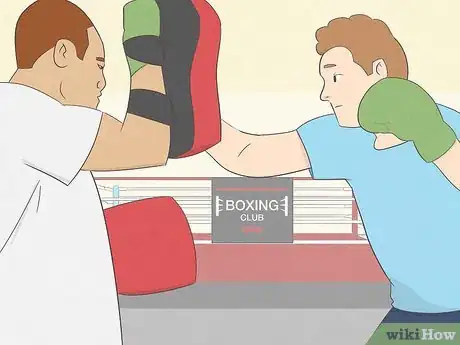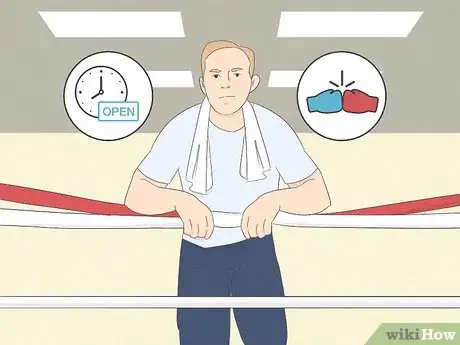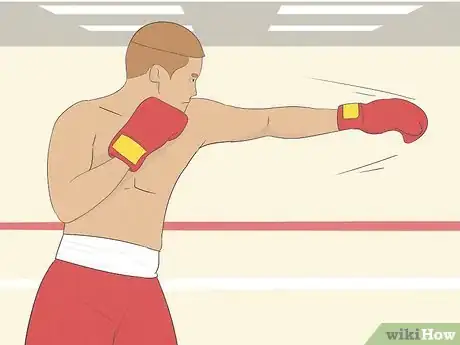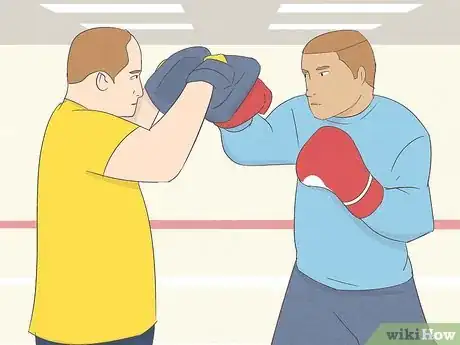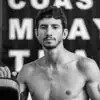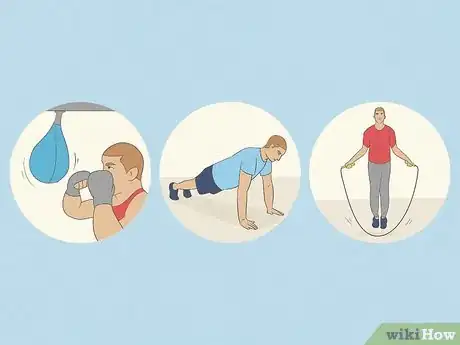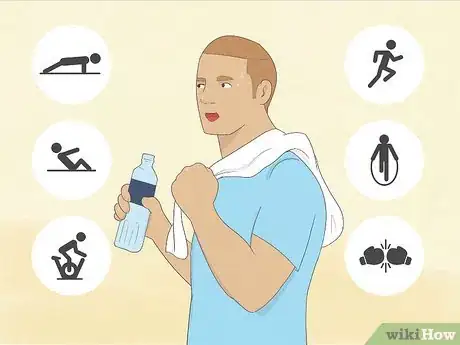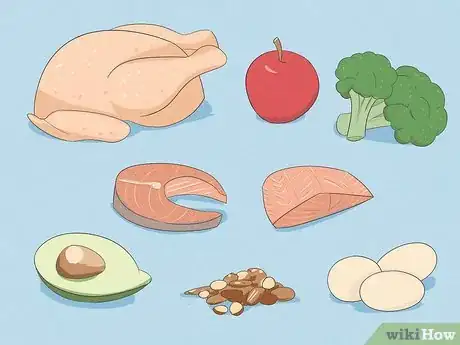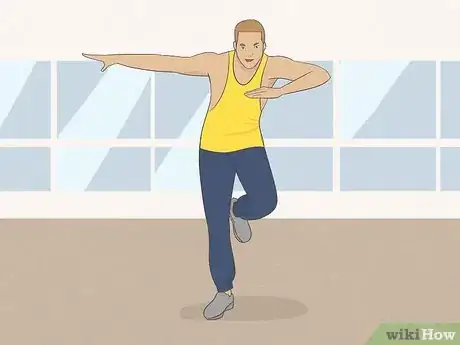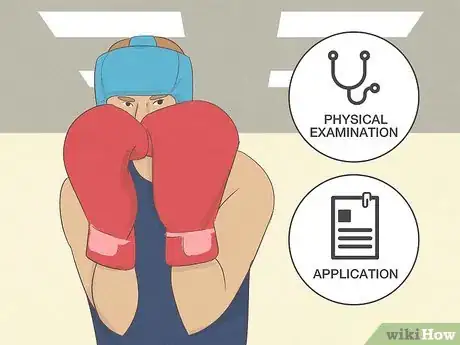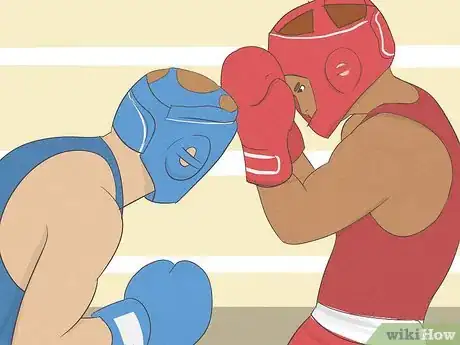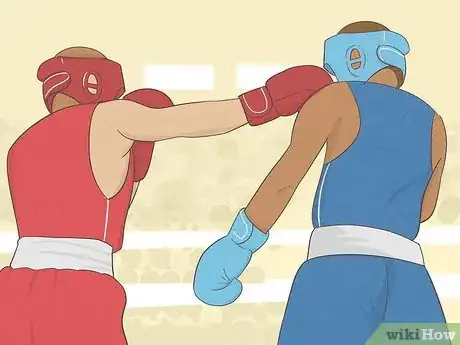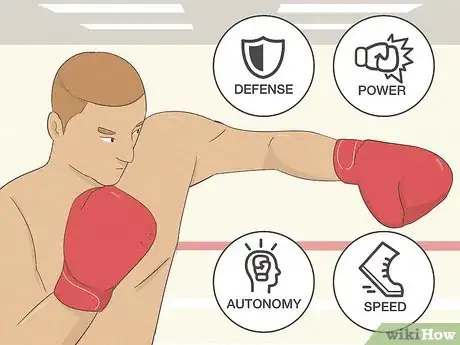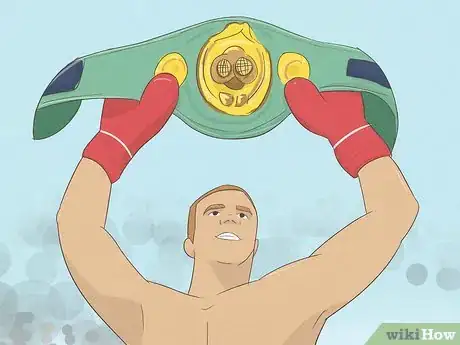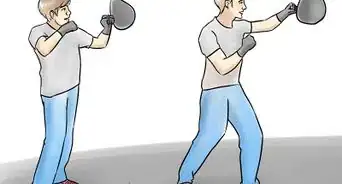This article was co-authored by David Engel. David Engel is a Muay Thai Instructor and Self Defense Trainer based in the San Francisco Bay Area. With over 15 years of martial arts instruction and training experience, David runs California Martial Athletics with co-owner Joe Chernay. He has created and maintained martial arts programs at Rise Combat Sports in San Francisco and Round 5 Martial Arts Academy in San Leandro, with a mission to provide students with a level of comfort and competency that manifests both within and outside the martial arts context. He is also a registered cornerman for amateur and pro competitors under the IKF (International Kickboxing Federation). David was the youngest apprentice instructor of the Thai Boxing Association of America under Ajarn Chai Sirisute (2009), and was a top-ranked amateur competitor in his weight class (127-130 lb) in California between 2013 and 2015.
There are 9 references cited in this article, which can be found at the bottom of the page.
wikiHow marks an article as reader-approved once it receives enough positive feedback. This article received 32 testimonials and 98% of readers who voted found it helpful, earning it our reader-approved status.
This article has been viewed 956,242 times.
For many people, boxing is a way of life and extreme sacrifices are made in pursuit of becoming a professional fighter. Whether you're already doing this or want to begin to pursue your boxing dreams, there's no better time than now to start taking the steps you need to take in order to become a professional boxer.
Steps
Joining a Boxing Club
-
1Choose a boxing club to join. You want one that is affiliated with a national boxing organization and that also has a reputation for training fighters. If you are serious about this, do not go to a health club that happens to have boxing classes. You need a gym that's dedicated to boxing (and potentially other martial arts).
- Odds are if you do a bit of asking around, you'll find the place that has the reputation as the best of the best in your area. There will likely be no doubt about it which club you'd like to join.
-
2Talk to a trainer. He will explain their hours of operation, fees and methods of training. You can also find out his experience as a boxing coach and whether he was a fighter himself at one point. Meet the staff and get a feel for the place. If it fills you with a sense of excitement and anticipation, it's probably right for you.
- Do ask questions. Find out what they would recommend for you and what kind of training you should start. What's their schedule like? Who would you work with? How can you meet everyone? Make sure you know what you're getting into before you sign up.
Advertisement -
3Check their membership. You want a club that has a wide range of clients at different levels. As you begin to develop your skills, you will want to start sparring with other people. A club with fighters at all different levels mean that there will always be someone for you to work with and that you can go grow with the club.
- Think of it like walking into a restaurant: if there's no one there, you wouldn't eat there. And if there's only people in blue hats and you're not wearing a blue hat, you might not eat there. If there's only people who seem to be miserable, you probably wouldn't eat there. So take a look – do the clients seem A) fit and competent and B) happy with their training?
- If you can, find someone who doesn't work there about the establishment. Sometimes you need an unbiased party to get an honest opinion.
-
4Familiarize yourself with the basics. Before you start working with a coach, it's probably a good idea to know at least the 101 of boxing and some of the terminology. You don't have to be good at it, you should just know a little of what your club peers are talking about. Here's a few starters:
- Jab. This is the busiest punch in boxing. It's a simple punch thrown to your opponent's chin with your leading hand (the hand of the forward foot).
- Cross. This punch is thrown with your dominant hand. It is a power punch. It involves a slight rotation of your torso, simulating a horizontal moment across your plane.
- Uppercut. This punch ends up in your opponent's chin or solar plexus. It's thrown at close range and can be quite the cincher.
- Hook. This is a short sideways punch delivered with your elbow out and to the side so your arm forms a hook.
- Southpaw. This is a left-handed fighter (either naturally or converted). To a "normal" fighter, they do everything in reverse. Because of their stance differences, they practically fight on top of each other.
- Outside and inside fighters. An outside fighter likes to keep his distance, stepping in for the jab. An inside fighter stays close, preferring moves like the uppercut.
Beginning Your Training
-
1Start working with your coach.[1] Your instructor will show you the basic boxing moves like jabs, uppercuts and hooks and instead of just knowing the terminology, you'll be getting good at it. You will also be given pointers in footwork, positioning and defense moves.
- A good trainer will also work on your secondary skills, like endurance and agility. When he sends you running around the block, it's for good reason. And don't expect to be sparring just yet – he'll let you know when you're there.
-
2Start a complete physical training regimen. The number of ways a boxer can better his or her body is endless. A good program will include heavy and speed bag punching, circuit training and jumping rope. You should be training outside of the ring several times per week at a minimum.
- You should be doing cardio and weight training, in addition to brushing up secondary skills with dance, yoga, interval training, and core exercises. That being said, have a day or so a week where you take it a bit easier – you don't want to wear your body out without even getting into a fight.
-
3Start some pretty intense workouts. These workouts should last 90 minutes and be done three to four times per week. A good boxing based workout would be 20 minutes of sit-ups and push-ups, 20 minutes on a stationary bike and then 30 minutes of jogging. The session could finish with 10 minutes of jump roping and 10 minutes of sparring with a punching bag or, if possible, another person.
- A 3-mile run shouldn't really be a problem for you. Combine it with jumping rope, jumping jacks, sit-ups, push-ups, and bag work.[2] See how long you last before you tire yourself out and your technique starts failing.
-
4Remember to stretch. You should be doing 20-30 minutes of dynamic stretching (rotating joints, working out any particularly stiff spots, no stretches held for a long time) before a workout and/or sparring. After any workouts spend a considerable amount of time doing some long static stretches (stretches that are held for a long time). This helps prevent injuries and reduce muscle stiffness.
- You may laugh, but taking up yoga isn't a bad idea. It'll help with your muscle tone, flexibility and reach, and get your entire body loosened up and ready for anything. That's not to mention the peace of mind and focus it can grant, too.[3]
-
5Begin your athlete's diet. All professional boxers follow some sort of diet or nutrition program. Working out means nothing if you aren't eating well. What's more, if you eat poorly, your performance won't be top notch. Your body is your moneymaker in this situation.
- What's a boxer's diet? It's high in healthy proteins – namely chicken, fish (like salmon and tuna), eggs, peanut butter and fruits and vegetables. It also includes sources of healthy fats, like olive oil, avocado, and nuts.[4] Your body needs a balance of nutrients, fat included, to make it through all the work you're forcing it under.
-
6Work on your endurance. You may think this means cardiovascular endurance, and it does, but it also means two other types of endurance:[5]
- Leg endurance. To be a great boxer, your legs are constantly moving. Sometimes in teeny, tiny moments, which can be even more difficult to make. After rounds and rounds of fighting, your legs will feel like cement. You can prolong your leg endurance by doing activities like jumping rope.[6]
- Shoulder endurance. When your shoulders are tired, say goodbye to your punches and your defense. You won't even be able to hold your hands in front of your face when your shoulders are down for the count. So work on that speed-bag and do arm endurance drills consistently.
-
7Train your mind, too. Boxing isn't just about boxing. Sure, that's the brunt of it, but you need other skills to make you well-rounded and ready for the future. Don't laugh just yet – consider a few of these ideas:[7]
- Take a dance class or two. Plenty of athletes, not just boxers, take dance classes. Why? Dance is all about balance, agility, and flexibility – three very important skills in sports.
- Take an acting class. You want to do promotions, commercials, and get sponsorships, right? You also don't want to look like an idiot doing them. So brush up on your skills in the spotlight to emphasize your charm.
- Study business or sports management. This is good for two reasons: A) you don't want to pull a Mike Tyson and blow all your money nor do you want to be taken advantage of by people who say "they deserve a cut" and B) you want a future. Your body won't be able to box forever, so having a more practical but related background can help you transition into coaching or promoting.
Becoming an Amateur Boxer
-
1Find your local amateur boxing organization. This can be solved by doing a quick search on the Internet or by talking to all your connections at your boxing club. When you're ready, your coach will likely let you know. You'll likely know, too.
- This step is more paperwork than anything. Visit USAboxing.org (if you're based in the US, of course) to get a list of information by state. Once you do this, you'll be able to find open events that you can participate in.
-
2Register as an amateur boxer. You will do this by filling out an application and undergoing a physical examination from your doctor. This is done at the state level through the State Athletic Commission when it comes to the US.
- You will have to contact the necessary people to get your license to compete in events. There is a minimal fee and it varies by state. Other than that, it's just a bunch of forms and a physical assessment.
-
3Participate in unsanctioned boxing events. These events are the way most fighters get their initial experience. The fights don't count towards your record, but are the safest and most practical way of getting experience. You'll be able to find them through connections and through your organization's website, which should post upcoming events.
- You'll be classed by age, weight, and record initially. You can be an amateur boxer in the US at just 8 years old!
-
4Begin your amateur boxing career. The difference between amateur and pro boxing is that you will be allowed to wear protective headgear. This is essential in the beginning stages of your fighting career in order to prevent potentially fatal injuries while you learn to protect yourself.
- Again, you will be placed according to your weight, age group and class, which will begin as "novice" if you're 17 or older. You'll start out in local and regional tournaments, with a long-term goal of competing in the U.S. Amateur Championships and earning a spot on the U.S. Boxing team.
-
5Don't just fill a vacant slot in a weight class. Some coaches are pretty sketchy. They'll encourage to fill a slot in a weight class just so you can get going and they can start profiting off of you. Don't do this – sometimes it's just not healthy and your body will take to injury much more easily.[8] Only compete where you feel comfortable, not where your coach says you should go.
- Think about where your weight normally stays around (provided it's consistent and you're fit, of course). You may be able to compete at about 5 pounds more or less than that, but anything greater will likely put strain on your body and be unhealthy.
-
6Get even more fit. You're going to be facing really, really talented individuals. You think you're fit now, but you'd be surprised the strides your body can make, especially when it comes to endurance. At this level, here's what you should be capable of:[9]
- Running 3–5 miles (4.8–8.0 km) without getting too tired
- Jumping rope for 30 minutes straight
- Hitting the heavy bag for 15 minutes non-stop
- Being able to spar with any amateur from any gym (not including pro-level amateurs with over 100 fights)
- Sparring double the required rounds (amateur boxing is 3 rounds)
Become A Professional Boxer
-
1Up your defense, speed, power, and sense of autonomy. Let's cover these four things separately:
- Defense. You'll be looking at anywhere from 60-150 punches per round. It doesn't matter how powerful your own punches are – you've gotta have that shoulder endurance and keep your defenses up and going at 100% at all times.
- Speed. You're fighting against opponents that are the speediest you've ever fought. It doesn't matter how powerful you are – if you can't get a punch in because you're too slow, you won't be getting anywhere.
- Power. This comes from good technique. Sure, throwing wild punches will catch your competition eventually, but you'll just wear yourself out. You've got to be able to concentrate your power and control it. Waste it and you've lost the match.
- Autonomy. By now, you need to be on autopilot. You don't have time to be thinking, "Okay...now I should do a left uppercut...keep your hands up, kid...oh, time to duck," that sort of thing. Every move needs to be a gut reaction.
-
2Find a manager. Your manager will have connections to boxing matchmakers who will set you up with fights. You will now be earning money, but keep in mind that at least 20% of your pay will go to the manager and the matchmaker. That being said, it's worth it – they're the ones working on beefing up your reputation.
- By now, you're probably pretty immersed in the boxing community. You'll know which managers are in your area and which ones are legitimate. If you have talent, they'll probably want to take you on. Just make sure it's someone you get along with and can trust.
-
3Don't quit your day job just yet. The biggest of the biggest boxers out there drive fancy cars, rake in the millions, and maybe only fight a few times a year. Then there's a middle tier that can score some airtime on TV and can make a quick couple of thousands of dollars. But then there's everyone else. You won't be bathing in gold coins for a while, so keep your day job for now.[10]
- It's kind of like Hollywood – you don't realize how many people are struggling to make it big. This is normal to start out. And keep in mind that up to 50% of your wages are going to the people below you, like your promoter or manager. Keep your income steady by having at least a part-time gig on the side.
-
4Get licensed. You will have to join a professional boxing association (IBF, WBC, WBO, or WBA) and get a boxer's license from the boxing commission you will be fighting in. There's a term for this called "alphabet soup." It's been coined because it seems like association after association is springing up like wildfire. If you don't like the sound of one, there's a dozen others you can consider.
- In the US, again, this is done at the state level. Each state has different requirements, ranging from experience as an amateur to having a manager. At the very least, have your birth certificate and social security card at the ready – there will be plenty of paperwork.
-
5Climb up the ranks. Your ultimate goal should be to win a championship belt. If you can hold belts in three out of the four associations, you will be classified as a "Super Champion." Holding all four belts makes you the "Undisputed Champion."
- This takes time and diligence, in addition to withstanding injury and defeat. Your skin will have to be thick in more ways than one. Boxing has a way of weeding out the weak of body and the weak of mind.
-
6Look to the pros for inspiration. The media has a way of glorifying specific types of people. The most famous boxers are the ones that were charismatic and ate up the camera, like Jack Dempsey. But if you dig a little deeper, there's no real stereotype boxers fit into, apart from the fact that very few aren't exactly average.
- Keep in mind that talent and accomplishment don't necessarily mean glory. Gene Tunney outboxed Jack Dempsey twice, but his self-contained demeanor kept him from living in the limelight, unlike his gregarious, extroverted opponent. Boxers aren't all looking for fame.[11] Take a cue from them that boxers come from all walks of life.
- Need inspiration that you can do it all? Turn to Calvin Brock, the "boxing banker." He was a well-educated man with a legitimate career in banking when he turned pro.[12] If you're already in college, don't sweat it. It's doable.
- On the other hand, you're never too young, either. Juan “Baby Bull” Diaz went pro at sixteen.[13] Sure, he didn't last long, but he still did it. Now he has a law degree and is still doing well for himself. Whichever road you take, you'll likely be fine.
Community Q&A
-
QuestionIs 24 years too old to start boxing?
 Community AnswerNo, as long as you're fit enough and your body can take it, you can box. However, before starting, you're advised to speak to your GP.
Community AnswerNo, as long as you're fit enough and your body can take it, you can box. However, before starting, you're advised to speak to your GP. -
QuestionIs there a minimum height requirement for boxing?
 Community AnswerNo, there is no minimum height required for boxing. You should focus on your training and technique.
Community AnswerNo, there is no minimum height required for boxing. You should focus on your training and technique. -
QuestionHow long does it take to become a pro boxer?
 Community AnswerPossibly about a year or so as an amateur, in which time the amateur boxing gives you more experience since it helps without affecting your record. The professional boxing career is then built on top of that and the time will vary depending on your opportunities and skill.
Community AnswerPossibly about a year or so as an amateur, in which time the amateur boxing gives you more experience since it helps without affecting your record. The professional boxing career is then built on top of that and the time will vary depending on your opportunities and skill.
Warnings
- Once you become a professional boxer, be very careful about not engaging in violent situations outside of the ring. If you attack someone with your hands and are arrested, it may work against you in court to have complete knowledge of your punching potential.⧼thumbs_response⧽
- A boxing career can lead to serious injuries which could be permanently damaging or fatal.⧼thumbs_response⧽
- You may be tempted to the sport by the thought of big money. Very few boxers make it to the top and for most, ring earnings act as a boost to regular earnings.⧼thumbs_response⧽
References
- ↑ David Engel. Muay Thai Instructor & Self Defense Trainer. Expert Interview. 5 May 2020.
- ↑ David Engel. Muay Thai Instructor & Self Defense Trainer. Expert Interview. 5 May 2020.
- ↑ http://www.apa.org/monitor/2009/11/yoga.aspx
- ↑ http://www.expertboxing.com/boxing-training/boxing-diet/a-healthy-boxers-diet
- ↑ http://www.expertboxing.com/boxing-basics/how-to-box/are-you-ready-for-amateur-boxing
- ↑ David Engel. Muay Thai Instructor & Self Defense Trainer. Expert Interview. 5 May 2020.
- ↑ http://www.freecollegeclasses.org/careers/professional-boxer/
- ↑ http://www.secondsout.com/ringside/training--conditioning/so-you-want-to-become-a-professional-boxer
- ↑ http://www.expertboxing.com/boxing-basics/how-to-box/are-you-ready-for-amateur-boxing
- ↑ http://www.freecollegeclasses.org/careers/professional-boxer/
- ↑ http://bleacherreport.com/articles/1651078-10-fighters-who-challenge-stereotypes-about-professional-boxing/page/2
- ↑ http://bleacherreport.com/articles/1651078-10-fighters-who-challenge-stereotypes-about-professional-boxing/page/3
- ↑ http://bleacherreport.com/articles/1651078-10-fighters-who-challenge-stereotypes-about-professional-boxing/page/4
About This Article
To become a professional boxer, start doing cardio and weight training exercises to build your strength and endurance. Make it a goal to work out 4 times a week for 90 minutes at a time. On top of training, start eating protein-rich foods, like chicken, fish, eggs, and peanut butter, to help you build muscle. Also, join an amateur boxing league so you can get some experience competing in the ring. To learn how to join a local boxing club to gain experience, keep reading!
